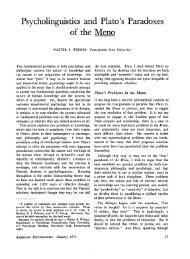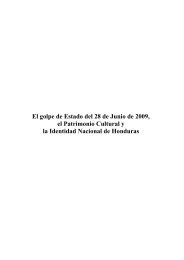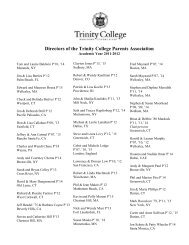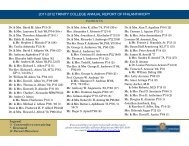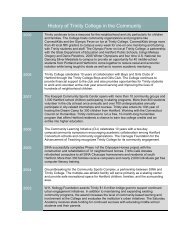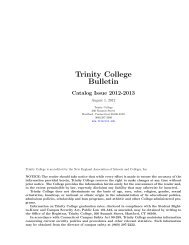Keisha-Khan Y - Trinity College
Keisha-Khan Y - Trinity College
Keisha-Khan Y - Trinity College
Create successful ePaper yourself
Turn your PDF publications into a flip-book with our unique Google optimized e-Paper software.
INAUGURAL WORKING PAPER SERIES<br />
FROM THE “MARGINS OF THE MARGINS” IN BRAZIL:<br />
Black Women Confront the Racial Logic of Spatial Exclusion*<br />
KEISHA-KHAN Y. PERRY (BROWN UNIVERSITY)<br />
VOL. I., NO. 5<br />
SPRING 2009
FROM THE “MARGINS OF THE MARGINS” IN BRAZIL:<br />
Black Women Confront the Racial Logic of Spatial Exclusion*<br />
<strong>Keisha</strong>-<strong>Khan</strong> Y. Perry<br />
Department of African Studies<br />
Brown University<br />
155 Angell Street – Churchill House<br />
Providence, RI 02907<br />
kyperry@brown.edu<br />
* Paper Number 5 in The Center for Urban and Global Studies at <strong>Trinity</strong> <strong>College</strong> Inaugural<br />
Working Paper Series to be published in May 2009. An earlier version of this paper was<br />
presented at the Conference “Rethinking Cities and Communities,” sponsored by The Center for<br />
Urban and Global Studies, <strong>Trinity</strong> <strong>College</strong>, November 14-15, 2008. We would like to thank<br />
Ahmed Kanna for helpful comments on earlier drafts, and Jason C. Percy, Managing Editor, for<br />
his skilled editing of this version. Please contact the author for permission to quote or cite<br />
material from this paper.<br />
1
“O MURO”<br />
eu bato contra o muro<br />
duro<br />
esfolo minhas mãos no muro<br />
tento de longe o salto e pulo<br />
dou nas paredes do muro<br />
duro<br />
não desisto de forçá-lo<br />
hei de encontrar um furo<br />
por onde ultrapassá-lo<br />
English translation:<br />
“THE WALL”<br />
I beat against the wall<br />
hard<br />
I scrape my hands on the wall<br />
I try to jump over it from far away<br />
I bang against the wall<br />
hard<br />
I don’t give up trying to force it<br />
I must find a way<br />
that I can get through it<br />
(Oliveira Silveira 1982, translated by <strong>Keisha</strong>-<strong>Khan</strong> Y. Perry)<br />
Introduction<br />
In Brazil, marginalization of the Black community accompanied the abolition of slavery,<br />
while miserable living conditions made the Black man a “declassified” citizen (Abdias do<br />
Nascimento, 1989 [1979]). “O muro” (The Wall), a 1982 poem by Afro-Brazilian poet Oliveira<br />
Silveira, embodies various meanings for the black majority of Brazil who often face social and<br />
economic barriers. The term “muro” may allude to the thick glass ceiling in the job market, the<br />
2
culturally biased university entrance exams, the police barricades, the gated communities, or<br />
even the man with the metal detector at the bank. The wall is a metaphor for understanding the<br />
gendered racial and class inequality that govern Brazilian cities. Finding a hole in the muro, or<br />
even attempting to climb over it, becomes a life-long struggle for black people, and even more<br />
so, for poor black women. 1<br />
Moreover, breaking down the muro is potentially dangerous and is<br />
likely to lead to injury or even death.<br />
In this essay, I focus on the actual wall that separates Gamboa de Baixo, a black coastal<br />
community located in the center of Brazil’s northeastern city of Salvador, from Morada dos<br />
Cardeais (House of the Cardinals), a 37-story luxury apartment complex built in 2005 by the<br />
world-renowned Brazilian construction firm Odebrecht. Concrete walls, I argue, signify racial<br />
boundaries, legitimate and illegitimate ownership, and segregation. Walls evince exclusion as<br />
much as invoke inclusion. They result in the “production of included and excluded bodies”<br />
(Razack, 2002, p. 10). Conflicts surrounding the building’s construction and current challenges<br />
to maintaining positive neighbor relations provide a glaring example of the social, physical, and<br />
economic segregation between rich and poor, and black and white residential communities in<br />
Brazilian cities.<br />
These conflicts must be understood within the context of current policy debates in Bahia<br />
surrounding the Direct Plan for Urban Development (Plano Director de Desenvolvimento<br />
Urbano, or PDDU), the plan for future urban development that many social movement activists<br />
argue privileges coastal and vertical construction (high-rises) for white middle- and upper-class<br />
Bahians. Although blacks have composed the majority of the coastal population since the slavery<br />
period, critics of the PDDU argue that the “orla será para quem pode (the coast will be for who<br />
can)” (A Tarde 3/15/07, emphasis added by author). In Bahia, the euphemism “quem pode (who<br />
3
can)” means those who can afford to pay for it. “Who can” are rich and white, while those “who<br />
cannot” are poor and black. 2<br />
Restructuring the city of Salvador threatens to expel poor black<br />
coastal communities from coveted lands along the Bay of All Saints as well as encourages self-<br />
segregation among Bahia’s white elite behind physical walls surrounding luxury condominiums.<br />
Walls, whether physical or symbolic, I argue, push women and blacks to the margins in<br />
the urban landscape, making them disposable subjects. Walls are the first visible signs of the<br />
disposal of black coastal neighborhoods during urban redevelopment processes. In Salvador, the<br />
marginalization of black communities operates simultaneously with urban removal, which<br />
involves arbitrary demolition, forced expulsion, and displacement. A police presence is central to<br />
constructing, maintaining, and disposing of black marginalized landscapes and the people who<br />
occupy them. As Katherine McKittrick and Clyde Woods (2007, p. 3) state, “black and poor<br />
subjects are disposable precisely because they cannot easily move or escape.” Black marginal<br />
subjects, then, are “declassified citizens,” who in the words of Abdias do Nascimento (1989), do<br />
not belong in the city center, and have no legal rights to the coastal lands.<br />
From the vantage points of black women who live in Gamboa de Baixo and lead the<br />
ongoing neighborhood movement against land expulsion and for land and housing rights, this<br />
paper will argue that community relations during urban renewal and land redistribution<br />
throughout the city is more fraught with racial tension and violence than may be apparent.<br />
According to Kia Lilly Caldwell (2007, p. 135), black women, especially those living in the<br />
poorest urban neighborhoods, have traditionally been consigned to a “de facto status of non-<br />
citizens,” occupying not only the spatial margins of cities but also the socioeconomic margins as<br />
the poorest of Brazil’s poor (Carneiro 1999; Silva 1997). This study advances the assumption<br />
that geographic margins should be understood as deeply connected to gendered and racialized<br />
4
socioeconomic status and marginality. This essay represents one aspect of my broader research<br />
concerning how black women’s resistance in Latin America and throughout the black Diaspora<br />
emerges from the urban margins, 3<br />
echoing Ruth Wilson Gilmore’s (2002, p. 16) claim that, “a<br />
geographical imperative lies at the heart of every struggle for social justice” and bell hooks’<br />
(1991, p. 449) assertion that, “this space of radical openness is a margin – a profound edge.<br />
Locating oneself there is difficult but necessary. It is not a ‘safe’ place. One is always at risk.<br />
One needs a community of resistance.” I consider Gamboa de Baixo to be one such community<br />
of resistance and claiming urban space and land rights constitutes a key political issue of black<br />
feminist struggles in Brazil.<br />
Below the Asphalt<br />
For the government and the big businessmen, poor people and blacks cannot nor should stay in the center<br />
of the city, much less along the coast. You may not notice, but we live in a very coveted paradise (paraíso<br />
cobiçado), that is worth a lot to us and attracts the fat eyes of big businessmen, that want to earn rivers of<br />
money from our homes at the cost of our misery and suffering<br />
(Gamboa de Baixo community meeting flyer, 1997, my translation).<br />
Physical barriers such as walls, gates, fences, and bars on windows are not unusual in<br />
urban communities, nor are they unique to Brazilian urban design (Caldeira 2000; Davis 1992).<br />
Walls demarcate boundaries and protect private and public ownership of property. Two main<br />
wall structures define Gamboa de Baixo’s geography on the urban coast and have been the focus<br />
of modern urban restructuring in Salvador. On the western shores of Gamboa de Baixo lies the<br />
São Paulo da Gamboa Fort (built in 1722 and named a Brazilian heritage site in 1937).<br />
Historically, Salvador was known as a “fortress city,” constructed in the mouth of the Bay of All<br />
Saints to function as a military and commercial port linked to other Portuguese transatlantic<br />
routes (Castro, 2002. p. 210). It marked the expansion of the Portuguese empire and the<br />
5
intensification of the transatlantic slave trade. Salvador was and is the capital of Portuguese<br />
America. The municipal government’s recent proposal to restore the São Paulo da Gamboa Fort<br />
is an effort to revive this colonial heritage (minus the memory of the terror and genocide of<br />
slavery and conquest) and to develop the coastal lands for maritime tourism. The restoration of<br />
historic monuments such as forts throughout Salvador, particularly in the center of the city and<br />
along the coastline, became the object of urban renewal during the mid-1990s (Perry, 2004,<br />
2005). In most cases, the revitalization of these monuments has led to the forced removal of their<br />
black and poor residents on the land on or surrounding them. As Radhika Mohanram (1999, p.<br />
150) says in The Black Body: Women Colonialism and Space, the predicament faced by<br />
marginalized communities during these historical revitalization processes exemplifies the ways<br />
in which “the colonizer is authorized to remake colonial spaces in the image of the mother<br />
country and to occlude extant, local history in the re-narrating and remaking of places.”<br />
Consequently, the state’s remaking of the history of the São Paulo da Gamboa Fort rendered<br />
invisible the history of the black families who have traditionally occupied the area as well as<br />
threatened the neighborhood’s permanence on the land. However, the Gamboa de Baixo<br />
community has resisted this displacement of local residents, some living inside the ruins of the<br />
fort, during and after the restoration process.<br />
6
Figure 1: Photo of Gamboa de Baixo neighborhood taken by author in 2000 before the construction of Morada dos<br />
Cardeais.<br />
The construction of Contorno Avenue by the technocratic and military government in the<br />
1960s has also shaped the neighborhood’s identity within the city and solidified socio-spatial<br />
hierarchies. The avenue segregated the Gamboa neighborhood; it created a literal wall between<br />
Gamboa de Baixo (Figure 1) and the upper-class neighborhoods of Gamboa de Cima (Upper<br />
Gamboa), Banco dos Ingleses (English Bank), Campo Grande, and Vitoria where the Odebrecht<br />
building is located. Gamboa de Baixo became a neighborhood “below the asphalt” of the avenue,<br />
and this moniker labels the neighborhood as a separate urban underworld marked by immoral<br />
and illegal activities and obscured from the public view by the modern Contorno Avenue.<br />
Official descriptions of Gamboa de Baixo typically portray these poor neighborhoods as<br />
disorganized spaces where black people reproduce poverty through sloth and immorality, as the<br />
7
following newspaper article demonstrates. Describing the Gamboa de Baixo slum that lived<br />
underneath the newly constructed Contorno Avenue in 1969, it claims that,<br />
Dirty and shady men populate the place, a community formed by thieves, prostitutes, and the feebleminded.<br />
The families who reside on the streets down at the bottom [near the ocean] complain about that<br />
sub-world [near the street]. One of the last victims of the marginais (criminals) was attacked in plain<br />
daylight. It was the case of an elderly woman, of approximately 70 years-old, injured by a crook. Before a<br />
man approaches, the women initiate a series of love invitations, almost dragging the victims by force to the<br />
malocas (huts/shacks)<br />
(A Tarde, October 4, 1969, my translation).<br />
In addition to exposing some internal class tensions and biases, this journalist declared<br />
the homes in Gamboa de Baixo as unfinished, unsafe, and unhygienic. In particular, the article<br />
condemned the women of the neighborhood as active participants, grabbing unsuspecting victims<br />
and dragging them into their supposed submundo (urban underworld) underneath the street.<br />
Many Bahians I have talked with have claimed not to know where Gamboa de Baixo is located<br />
while simultaneously claiming to know that the neighborhood is violent, drug-ridden, and full of<br />
prostitutes, or a place where marginais (criminals), both male and female, of the worst kind live.<br />
Thus, in the public imagination, Gamboa de Baixo is both visible and invisible, in plain view and<br />
out of view, a socio-spatial divide created by the avenue that serves as a wall above the<br />
predominantly black neighborhood.<br />
Until the 1990s, and before the fruits of the political struggle led by a grassroots black-<br />
feminist movement had ripened, the neighborhood “below the asphalt” was forgotten, abandoned<br />
by city officials, and lacking in basic services such as potable water, electricity, and sewage<br />
removal systems, which were standard features due to urban development throughout the rest of<br />
the city. When the municipal government proposed to forcible removal of the local black<br />
population to create a recreation park around the São Paulo Fort, the neighborhood suddenly<br />
8
ecame hyper-visible, figuratively and literally. Neighborhood mobilization against relocation<br />
threatened the modernist design aspirations of urban architects and engineers, who discussed the<br />
development potential of the coastal lands without the participation of local residents. State<br />
agencies used the underdevelopment and supposed marginality of the area to justify a massive<br />
moral, social, and physical “clean-up” and “renewal,” initiative - a strategy used to remove poor<br />
black residents from the Historic Center and Agua Suja neighborhoods previously (Collins,<br />
2008; Dunn, 1994; Espinheira, 1989; Filho, 1999). Like these displaced urban populations, many<br />
Gamboa de Baixo residents share a collective memory of living on the coast and in the city-<br />
center since the colonial period.<br />
The Fortresses Within<br />
As black women in Gamboa de Baixo have fought to stake their claim to the land below<br />
the asphalt and on the land around the historic fort, another wall has emerged as a popular feature<br />
of neighborhood housing design. In recent years, the number of homes in the Gamboa de Baixo<br />
neighborhood with enclosed verandas and front door grades (metal bars) or with walls around<br />
their perimeters has increased significantly. For some local residents, the walls and the grades<br />
protect them from both internal and external threats, specifically from the drug traffickers and<br />
the police who many residents believe contribute to the increase in violent crime and a create<br />
generalized culture of fear.<br />
One longtime resident, Simone, who is currently completing construction on a large two-<br />
story house, decided to build concrete walls around the perimeter of her property. I joked with<br />
Simone during a recent tour of her future home, “Are you building a mansion or a fort?”<br />
9
We both laughed and blurted out simultaneously, “A Forte da Simone (Simone’s Fort)!”<br />
“You wait until I put broken glass on top of it,” she said still laughing, “not even the rats<br />
will want to climb over that wall!”<br />
However, Simone was less worried about the rats; her concerns about the possibility of<br />
theft, the use of her backyard as an escape route for police fugitives, and the fear of gunfire<br />
flying through the atmosphere, were very real. The need for the wall as a barrier became even<br />
more crucial when during this past January during a police raid, when the police fired directly<br />
into the unfinished concrete walls of the home’s interior. “Imagine if the house had been finished<br />
and we had been living inside?” Simone said.<br />
I could not imagine. I touched the hole where one bullet had lodged into the wall. “It<br />
looks like you’ll need a concrete roof too.”<br />
Rubbing her thumb against her index and middle finger, a local expression to signal that<br />
she will need money for that, she nodded, “certainly.” For Simone and many of her neighbors,<br />
the wall is a matter of life or death.<br />
Urban theorists have given little attention to precisely how poor people perceive fear and<br />
how they are also building “fortresses” and other mechanisms of security around themselves.<br />
Fortresses are no longer limited to the colonial past, modernist urban designs, or to elite<br />
residential communities. The assumed safety of a small, everybody-knows-your-name seaside<br />
community has disappeared. The focus on walls and grades within the Gamboa de Baixo<br />
neighborhood illustrates the fear that poor black people experience, but also shows that in this<br />
instance, residents demonstrate their preference to stay put and not translate that fear into what<br />
development agents have argued is the “inevitable removal” of its residents from that area of the<br />
city. Gamboa de Baixo residents, albeit with limited resources, continue to build homes and the<br />
10
security mechanisms necessary to protect them as a way to remain on the urban land where they<br />
have claimed property rights. In other words, they build the walls and the grades as a way to<br />
contain themselves as a practice of self-inclusion on the coastal lands rather than exclusion from<br />
it; they do not envision living anywhere else.<br />
Spatial Entitlement and Exclusion<br />
[T]he territoriality of power is key to understanding racism (Gilmore, 2002, p. 22).<br />
Residents’ views of the walls of the São Paulo da Gamboa Fort, Contorno Avenue, and the walls<br />
of Gamboa de Baixo offer insights into how residents view the wall that now divides Morada dos<br />
Cardeais and the Gamboa de Baixo communities. For anthropologist Teresa Caldeira (2000),<br />
Brazilian cities such as São Paulo have become “cities of walls” where “residents from all social<br />
groups argue that they build walls and change their habits to protect themselves from crime” (p.<br />
297). In residential high-rises, the basic elements are “security, facilities, services, and location”<br />
(p. 257). Caldeira also argues that, “fortified enclaves confer status. The construction of status<br />
symbols is a process that elaborates social differences and creates means for the assertion of<br />
social distance and inequality” (p. 258). These “fortified enclaves” exemplify the modern ideal<br />
of city living. Urban theorist Mike Davis (1990, pp. 225-226) similarly describes Los Angeles as<br />
a “fortress city,” where magnified perceptions of the threat of violence from the so-called<br />
“criminal underclass” (young black men and poor Latino families) dominate the white middle-<br />
class imagination. This fear mobilizes middle-class communities to self-isolation in residential<br />
“fortresses” equipped with security systems aimed at keeping out the criminal poor. This fear has<br />
less to do with the crime rates than with status, for as Davis argues, poor people in cities worry<br />
just as much about violent crime as do rich people (p. 224). Furthermore, in cities such as<br />
11
Salvador, black women like Simone in Gamboa de Baixo, head their households and lead social<br />
networks in their communities, as well as serves as the main decision makers about housing<br />
design, which increasingly incorporates physical forms of protection.<br />
A low wall constructed by the Archdiocese of Bahia, the previous landowner, existed on<br />
the eastern perimeter of Gamboa de Baixo before Odebrecht bought the property. Odebrecht<br />
extended the height and width of the wall before the construction of Morada dos Cardeais even<br />
began in 2003. Gamboa de Baixo residents, who subsequently lost significant access to space in<br />
their backyards, greeted the wall with suspicion. The previous wall of the Catholics did not<br />
extend to the oceanfront, while the new Odebrecht wall made growing vegetables and fruits on<br />
the land impossible, and one Gamboa home was demolished during the process of building it.<br />
The extension of the wall from Contorno Avenue to the beach was just the beginning of the<br />
numerous problems that surfaced as a result of Odebrecht’s acquisition of the coastal lands for<br />
construction of the luxury apartment community.<br />
Figure 2: Photo of the eastern perimeter of Gamboa de Baixo and Morada dos Cardeais taken by author.<br />
12
As Odebrecht completed construction of Morada dos Cardeais in 2005 (Figure 2), the<br />
international religious community paused to mourn the death and commemorate the life of the<br />
revered “people’s pope,” John Paul II, whose death added further historical significance to the<br />
land and the former house of the Catholics situated on its grounds that had housed some of<br />
Brazil’s most important cardinals for almost a century. The pope had also visited the home in<br />
1980 and 1991. When urban architect Diogenes Rebouças designed Contorno Avenue, he opted<br />
not to demolish the historic mansion and built a viaduct underneath it. The house still remains on<br />
the land, and the historical site was restored as part of the new apartment complex. Ironically,<br />
Gamboa de Baixo activists negotiated with the Catholic Church for several years for ownership<br />
of the part of the land their community occupies. The archdiocese never transferred collective<br />
ownership to the community, and instead sold the former Catholics’ house and the land that<br />
included an area where Gamboa residents continue to live. This transaction between the Catholic<br />
Church and Odebrecht occurred without the knowledge of the community, exemplifying years of<br />
strained relationships between the community and the Archdiocese of Salvador.<br />
Ana Cristina, a Gamboa de Baixo activist critical of the Church’s history of land<br />
usurpation, affirmed that with the construction of the new wall, Odebrecht physically reinforced<br />
what existed symbolically. Though the previous wall hardly posed a barrier to residents, and the<br />
cardinals who resided inside had no security mechanisms at their disposal, the previous wall also<br />
served as a marker of spatial and social separation between the elite house of white cardinals and<br />
the poor and black Gamboa de Baixo fishing community. As an Odebrecht representative<br />
confirmed (personal communication, 2004) during meetings with Gamboa de Baixo activists,<br />
“Priests don’t sell anything for cheap.” This statement supports community activists’ claims that<br />
the land sale to the corporation contradicted popular and global discussions of the Church’s<br />
13
defense of marginalized black and indigenous groups in Brazil. In this sense, a wall is a wall is a<br />
wall, 4<br />
and Ana Cristina asserts that although they previously moved freely about the coastal<br />
lands, as their black and indigenous ancestors had done prior the Church’s occupation, without<br />
land titles, they now have little claim to it. The wall remains a constant reminder of this lack of<br />
collective entitlement, a crucial exclusion from property rights that James Holston (2008, p. 113)<br />
argues has “fatal consequences for Brazilian citizenship.”<br />
The women of the Gamboa de Baixo neighborhood association used media reactions to<br />
the luxury development project to force Odebrecht to make important decisions regarding land<br />
distribution. Local journalist Mary Weinstein (A Tarde, August4, 2004) published a controversial<br />
article entitled, “Realidade Concreta da Gamboa (Concrete Reality of Gamboa),” highlighting<br />
the problems surrounding the construction on Contorno Avenue and projecting the problems the<br />
Odebrecht building would pose for Gamboa de Baixo residents, such as land usurpation and the<br />
privatization of the local beach. Weinstein’s critiques reflected ongoing debates about the<br />
government’s urban development practices as outlined in the current Direct Urban Development<br />
Plan, which in addition to privileging the city’s minority white elite also compromised the<br />
environmental stability of the land. She also questioned whether the coastal lands could<br />
permanently support a 37-story concrete structure and whether Odebrecht could build the pier<br />
without much destruction to the vegetation, the bay’s ecosystem, and the land on which Gamboa<br />
de Baixo residents lived.<br />
During these debates, Odebrecht never publicly suggested that they had planned to<br />
displace the Gamboa de Baixo population from the land, but representatives admitted that as a<br />
result of the political organization of the neighborhood, they had to change some of their original<br />
construction plans, which had included the destruction of several more Gamboa de Baixo homes.<br />
14
However, the erasure of Gamboa de Baixo in the marketing information that Odebrecht<br />
distributed to potential wealthy buyers piqued the interest of neighborhood activists. In an<br />
enlarged photograph of the future building that spanned four pages in the booklet, Odebrecht<br />
deleted some of the area where Gamboa lies and replaced most of the neighborhood with an<br />
image of a flush green landscape that includes the São Paulo da Gamboa Fort and the restored<br />
homes of the Solar do Unhão neighborhood. As one resident stated, “the design plans show all of<br />
this full of trees. When the buyers come to live here they will see that it is not so green” (quoted<br />
in Weinstein, 2004). The Gamboa de Baixo neighborhood is also typically visibly absent from<br />
the “revitalized” landscape in state urban development brochures. For Gamboa de Baixo<br />
residents, the marketing materials represented a state-supported ideal for the land, a place for the<br />
white elite to live and play without black and poor neighbors, which reflects broader urban<br />
development efforts to “cleanse” the area of this “marginal” population. This exemplifies the<br />
contradictions of urban redevelopment evident in a statement made by state agents during<br />
negotiations with Gamboa de Baixo residents in the mid-1990s: “Gamboa is the face of Bahia,”<br />
but “it is not an area for black and poor people (pretos e pobres) to live” (personal interview,<br />
January 2007).<br />
For Gamboa de Baixo activists engaged in a decade of struggle against forced removal,<br />
and for land rights and participatory urbanization, Morada dos Cardeais meant the heightened<br />
threat of displacement of traditional black fishing colonies from the coast. “Gamboa de Baixo is<br />
on very delicate line [in terms of public space],” one activist affirmed in a meeting with<br />
Odebrecht representatives. Another added, “We have to be alert. Alert to everything,<br />
because….they [the State] have the revitalization of the Commercial District; they have the<br />
revitalization of the Historic Center. Gamboa is in a dangerous zone. And just because it’s<br />
15
Odebrecht doesn’t mean we are not going to think about these things…We know what has been<br />
the history of residential removal in the violent form that we have had to deal with it” (quoted in<br />
Weinstein, 2004). The Gamboa de Baixo community is effectively under siege from all sides.<br />
Both state and private urban developers envision a lush green landscape below Contorno<br />
Avenue, the restoration of a fort accessible from the Bay of All Saints, and the consumption of<br />
coastal luxury. In fact, concrete walls (and not black people) have now become part of the<br />
“ideal” natural coastal landscape.<br />
Visibility and increased surveillance<br />
With the introduction of infrastructural services and mechanical transports, there is no longer the<br />
necessity of the constant presence of poor people and blacks, now that it only interferes with the<br />
idealization of the “white” city and its European appearance<br />
(Eloísa Petti Pinheiro, 2002, p. 260, my translation).<br />
In the apartments of Morada dos Cardeais reside some of Bahia and Brazil’s wealthiest<br />
people, and even boasts a celebrity in Axe music singer Ivete Sangalo, who lives in the<br />
penthouse. This elite group of residents cannot only afford to live there, but they can also afford<br />
to purchase the goods necessary, such as yachts, to take full advantage of the available amenities,<br />
such as the modern pier accessible by cable car. Protection by sophisticated security systems<br />
installed on the property represents a necessary aspect of the luxurious lifestyle. In addition to<br />
working inside the building, armed security guards work on the pier 24 hours a day to regulate<br />
the approximation of Gamboa de Baixo residents. However, local residents have resisted any<br />
attempt by Odebrecht to privatize the waters around the pier.<br />
16
Figure 3: Photo of Gamboa de Baixo professional diver and activist in the<br />
neighborhood association and fishermen and fisherwomen’s association, Angela,<br />
taken by author.<br />
These security guards discourage any type of physical contact with the piers by using<br />
buoys to demarcate their territories within the public waters. As Angela, a professional diver who<br />
is a board member of the neighborhood and fishermen and fisherwomen’s associations,<br />
recounted, “they think that we are pirates, that we will jump out of the water to rob them, and<br />
then row our boats back home” (personal communication, 2003; Figure 3). Angela motions the<br />
17
act of frantically rowing, as she tells me of the frequency of violent encounters between these<br />
security guards and Gamboa de Baixo fishermen and women, which expresses what she<br />
considers to be the “ridiculous,” yet systemic criminal assumptions about black men and women.<br />
Angela also tells me the story of how a yacht almost killed her and another female diver when<br />
boaters ignored them in the water. As many residents have affirmed, they feel increasingly<br />
displaced from the previously unregulated land and waters of the bay by the white elite, who act<br />
as if they are the only ones entitled to it. These sentiments of entitlement are widespread enough<br />
for these luxury condominiums to invest significant resources into keeping Gamboa de Baixo’s<br />
black residents out of public waters. Teresa Caldeira (2000, p. 4) writes, “privatization,<br />
enclosures, policing of boundaries, and distancing devices create a public space fragmented and<br />
articulated in terms of rigid separations and high-tech security: a space in which inequality is an<br />
organizing value.” As the experiences of Gamboa de Baixo residents with privatized policing<br />
show, gendered, racial, and class inequality govern “fortified enclaves” in Bahia (Caldeira,<br />
2000)—and, it might be argued, in other cities such as Miami and Los Angeles. Of course, no<br />
state security mechanisms are in place to regulate these kinds of illegal private security practices.<br />
The Bahian elite’s preoccupation with security in this coastal region is the direct result of<br />
public stigma of violence attached to Gamboa de Baixo, and poor black neighborhoods in<br />
general. As activist Ana Cristina states, “everyone ‘below Contorno Avenue’ is considered<br />
criminal” (personal communication, 2004). The media is the primary contributor to this negative<br />
view of the neighborhood when they report crimes committed along Contorno Avenue. If a<br />
crime occurred in a neighborhood above Contorno Avenue, they report that it took place in<br />
Gamboa de Baixo and that Gamboa de Baixo residents committed it. For example, a murdered<br />
man was found more than a kilometer from Gamboa de Baixo in 2004, but the newspaper<br />
18
eported he was a victim of criminal activities in the neighborhood. The man neither was a<br />
resident of Gamboa de Baixo nor was his death related to anyone in the neighborhood. As one<br />
resident claimed at the time, “a man dies in Campo Grande, what does that have to do with<br />
Gamboa? Why do we have to pay the price for crime in the entire city?” As a newspaper<br />
reporter recently affirmed, “all black people continue being perceived as potential bandits or<br />
drug dealers without justification or explanation” (A Tarde, June 9, 2008).<br />
Gamboa de Baixo residents believe that the construction of Odebrecht’s wall and the<br />
installation of security apparatuses demonstrate the broader public’s disparaging sentiments<br />
about their community and the people who live there. As some residents have stated, part of the<br />
ongoing political struggle is to prove that “somas gente também (we are people too)” (quoted in<br />
Weinstein, 2004), and that in Gamboa de Baixo, there are people who work and raise healthy<br />
families in an environment they have enjoyed for generations prior to the white elite’s urban<br />
redevelopment interests. In fact, poor blacks have always occupied coastal lands, when those<br />
areas of the city were considered undesirable places for the elite to build their homes. As another<br />
resident affirmed, “every one has to live her life. If they are barões (barons or rich boys) and just<br />
defend their rights and want everything to themselves, that’s not going to work. They have to<br />
think about others too” (quoted in Weinstein 2004). Gamboa residents, it appears, do not plan to<br />
leave the land, and are demanding that their neighbors share the land, the beach, and the waters<br />
of the Bay of All Saints. The “barons,” as Gamboa de Baixo residents refer to the wealthy<br />
residents of the high-rises, may want everything for themselves, including the paraíso cobiçado<br />
(coveted paradise) of the coast, but as Gamboa de Baixo community leaders and local residents<br />
reassure them, “that’s not going to work.”<br />
19
Residents’ demands to share the “coveted” coastal landscape have meant that, despite the<br />
private security and walls, the wealthy white residents of Morada dos Cardeais must also grapple<br />
spatially with daily state military policing in their neighborhood. In fact, some Gamboa de Baixo<br />
residents believe this increased policing is directly related to residential class and racial shifts in<br />
the coastal landscape (Weinstein, 2004; personal communication, 2008). The public police serve<br />
to protect not Gamboa de Baixo residents, but the elite who live around them. Some local<br />
residents wonder whether these white elites have not come to expect public police reinforcement<br />
in the area in addition to the private security they can afford.<br />
Many Gamboa de Baixo residents now view violence, specifically police violence, as a<br />
spectacle for residents of Morada dos Cardeais, who look down from the 37 stories onto the<br />
residents who are living the systemic violence. In essence, both communities experience policing<br />
differently: in Morada dos Cardeais, the wall and private police protect their residents, while in<br />
Gamboa de Baixo, “fortress homes” like those of Simone cannot isolate them from the violence<br />
of state military police forces. Thus, the wall alone does not account for the spatial difference<br />
between the communities; the actual height of the Odebrecht building becomes an inherent<br />
geographic difference in how the two communities view each other. In everyday life, especially<br />
during moments when ordinary policing in Gamboa de Baixo become extraordinary events,<br />
Morada dos Cardeais residents enjoy a unique view from above. Thus, the act of witnessing<br />
violence is shaped by marked spatial inequalities in the landscape. From below, Gamboa de<br />
Baixo residents can never access the everyday lives of those who live above them in the high-rise<br />
apartments (unless they work as domestic workers or doormen, but no Gamboa de Baixo resident<br />
works in Morada dos Cardeais) nor can they experience the privilege of spatial protection.<br />
20
Gamboa de Baixo residents cannot climb over the wall, whether real or imagined.<br />
Figure 4: Photo of Bahian newspaper A Tarde’s front page on January 5, 2008 taken by author. Captions read:<br />
“Police shoot at homes and injure young person in Gamboa” and “Police jump over the wall of Contorno Avenue to<br />
search persons that [unreadable].”<br />
This spatial difference in protection became evident during the December 2007 violent<br />
police raid and the first violent police raid of 2008 in January (Figure 4). Police operations in<br />
Salvador’s black and poor communities increase before carnival festivities in the city. Known as<br />
“operação pente fino,” or “operation fine-tooth comb,” the police comb these black and poor<br />
neighborhoods for so-called criminals whom they perceive to pose a threat to the lives of tourists<br />
who flood the city. These actions are not unlike those of New York City’s “zero tolerance<br />
against crime” policies under the Giuliani administration or those in Mexico City or in Rio de<br />
Janeiro neighborhoods before 2007’s Pan-American games, which led to the massacre in the<br />
Complexo do Alemão (Smith, forthcoming). M. Jacqui Alexander (2005), Ruth Wilson Gilmore<br />
(2007), Joy James (2000), Denise Ferreira da Silva (2007), João H. Costa Vargas (2005), among<br />
many others, have written on the globalization of aggressive policing and the dehumanizing<br />
impact on African descendant populations. In Brazil, as police raids on black communities led to<br />
21
increased incarceration rates, black movement and human rights activists increasingly criticized<br />
state proposals to keep poor blacks in flotation prison tanks in the middle of the Bay of All Saints<br />
until after carnival in February.<br />
In this context, these December and January police actions are examples of the everyday<br />
police force in Gamboa de Baixo, but as in the case of the “floating prisons,” they also represent<br />
extraordinary moments in urban policing. On December 28, 2008, local residents witnessed the<br />
unprecedented use of helicopters flying low around the perimeter of Gamboa de Baixo with<br />
officers rappelling out of helicopters and onto the local beach, which some residents claimed,<br />
“appeared like a scene out of a war zone” (personal communication, 2008). It was the first time<br />
that elite SWAT teams, equipped with firearms and machinery were sent to, as residents<br />
imagined, “demolish and to eliminate (kill)” (personal communication 2008). In this type of<br />
urban war, the police “shoot first, ask later” (personal communication, 2008). Morada dos<br />
Cardeais residents watched the “war” from the safe confines of their balconies.<br />
The January 4 police raid was another such scene from the “war zone.” Speculations<br />
about the entire operation dominated conversations within the neighborhood for days afterwards.<br />
Bullets penetrated the roof of one elderly resident’s house, who later recounted to neighbors and<br />
the news media that, “the police arrived here firing gunshots. I had to hide underneath the bed”<br />
(A Tarde, January 5, 2008). Her dog had hid with her. From the walls of Contorno Avenue to<br />
the walls of the fort, the neighborhood, all agreed, had been “terrorized.”<br />
For Gamboa de Baixo residents, the increased presence of luxury apartment communities<br />
on the coastal lands of Salvador directly leads to the increased public policing of the area. Black<br />
feminist theorist Patricia Hill Collins (1998, p. 51) points out that blacks’ heightened “visibility<br />
can bring increased surveillance.” Classed racist-sexist ideologies mark them as “‘not quite’<br />
22
legitimate” citizens whose lives are expendable (McKittrick, 2006, p. 62). Black Brazilian<br />
sociologist and feminist militant of the black movement Vilma Reis (2008) wrote a few days<br />
after the January operation in Gamboa de Baixo that, “in Salvador, second largest black city on<br />
the planet, where to be black is still synonymous with dangerous, undesirable, out of place, and<br />
fundamentally, descartável (disposable),” violence against poor black people has become<br />
routine, and for some, an expected element of urban governance (see also Maravalho, 2008).<br />
Black neighborhoods such as Gamboa de Baixo are portrayed as fora de controle (out of control)<br />
morally, socially, politically, and spatially. Many residents feel they are being unfairly<br />
criminalized, such as Nicelia, a 28-year-old black woman, who often says, “não sou marginal,”<br />
to insist that she is not a criminal. As another resident, Camilo, explains how his experiences<br />
with police abuse and the general criminalization of Gamboa de Baixo connect with the police’s<br />
racialization of local residents:<br />
It has to do with the fact that I am black, that I live in a neighborhood like here that has its highs and lows,<br />
negatives and positives. Here has a good side and a bad side…The negative side is the drugs, and they<br />
think in their point of view that everyone that lives here have some involvement with drugs, something that<br />
is not true. Because they are many pai de familia (family men) hard-working, like they have everywhere,<br />
even in the big mansions of rich neighborhoods<br />
(personal interview, December 2003).<br />
Contrary to public perceptions that the police are doing their job of cleansing the area of<br />
criminals as a necessary part of the process to socially improve the urban landscape, local<br />
residents understand that they are undeserving of such inhumane forms of violent treatment; the<br />
entire neighborhood is being marginalized, criminalized, and destroyed simultaneously.<br />
23
The Racial Logic of Spatial Exclusion<br />
This perspective bridges the theoretical gap between analyses of the violence of unequal<br />
urban development and the violence of urban policing. By emphasizing the overlap between the<br />
two processes, I encourage readers to think about the emergent need for black social movements<br />
in Brazil and elsewhere to combat the image of “collective pathology” (Gilmore, 2002) while<br />
struggling to gain access to vital urban resources such as housing, land, and basic sanitation.<br />
Gentrification, urban redevelopment, urban revitalization, urban renewal, whatever the term we<br />
use to describe these modern urbanization processes, reveal that for black communities, urban<br />
clean-up campaigns can be radically exclusionary and dangerously violent (Dávila, 2004;<br />
Hoffman, 2008; Pinheiro, 1999). In Brazil, the naked truth of urban renewal exposes the<br />
contradictions of modernity: the national desire to align Brazilian cities with other global cities<br />
such as Paris, New York, and Frankfurt, and the growing black urban population who must fight<br />
against state and private developers to belong as landowners and citizens in a robust new and<br />
developed city (Pinheiro, 1999). The black struggle for citizenship constitutes an urgent demand<br />
for racial inclusion in development, expanding discourses and practices to take urban grassroots<br />
anti-racism strategies seriously.<br />
One concern of my ongoing ethnographic research has been to examine how the<br />
modernizing project in Salvador is a racial project 5 posing damaging effects for poor black<br />
neighborhoods caught in between their own desire for improved living conditions through<br />
inclusive socio-economic development and urbanization and the bulldozing private and public<br />
enterprises that seek to forcibly remove them. I assert that urbanization practices illustrate the<br />
racial and gender consciousness of the State and the ways in this form of race-based knowledge<br />
determines socio-spatial ideologies and concrete actions. This recognition exemplifies what João<br />
24
Costa Vargas (2004) terms the “hyperconsciousness/negation of race dialectic,” which defines<br />
social relations in Brazil. Vargas claims that, on the one hand, most Brazilians negate the<br />
importance of race in structuring institutions, shaping social relations, and determining the<br />
distribution of resources and power. On the other hand, Brazilians are “acutely aware of racial<br />
differences and utilize those to (often tacitly) justify, think about, and enforce behavior and<br />
social inequalities” (6). This hyperconsciousness/negation dialectic is useful in understanding<br />
how Bahians are simultaneously hyperconsciousness of the racial aspects of urbanization<br />
policies while also negating the salience of race in the new socio-spatial order. However, the<br />
black communities that are most negatively affected by the forced displacement from the<br />
“better” parts of the city understand that gentrification shapes racial, class, and gender<br />
landscapes of the city. As a Gamboa de Baixo neighborhood association activists wrote in a press<br />
release more than a decade ago, and which still has political saliency as the Direct Urban<br />
Development Plan advances and more buildings like Odebrecht are constructed around them,<br />
“the dissemination of this culture of exclusion…principally towards the black and poor<br />
population, distances it farther and farther from the so-called privileged areas of the city” (p.<br />
1996).<br />
For Gamboa de Baixo, the new building further threatens not only the neighborhood’s<br />
permanence, but also the livelihood and collective safety of its resident black majority. Morada<br />
dos Cardeais is a private development project that Gamboa de Baixo activists consider to be part<br />
of ongoing state-sponsored efforts to revitalize the coastal lands along the Bay of All Saints for<br />
tourism and luxury real estate. Such development further reproduces gendered racial and class<br />
hierarchies, heightens private and public security in the region, and contributes to the<br />
criminalization of the Gamboa de Baixo neighborhood. Salvador’s “racial state’s aggressively<br />
25
punitive stance” (Gilmore, 2002, p. 21) on combating urban crime has created a state police<br />
apparatus that “formalizes inequality” (p. 21) and deepens racist justifications to demolish this<br />
poor neighborhood and relocate its black residents to the distant periphery of the city. The<br />
context of daily acts of violence as well as systemic police operations signifies the “policy effect<br />
of producing” (p. 21) entire neighborhoods as marginal and criminal. Policing black<br />
neighborhoods such as this one represents not only a politics of spatial containment, but also a<br />
politics of absolute spatial exclusion in the simultaneous State actions of demolition and police<br />
abuse. By examining policy-driven misconceptions of Gamboa de Baixo and its residents as<br />
inherently violent, unhygienic, and morally bankrupt, we are better able to understand how<br />
enduring public gendered racist images of both black women and men shape the politics of<br />
disposability and demolition during urban renewal processes. In this dominant view, Gamboa de<br />
Baixo, as a whole, is not just dangerous, but also it does not belong on the coastal lands; in<br />
essence, it threatens urban progress.<br />
Conclusion: Spatial Justice<br />
I have been locked by the lawless.<br />
Handcuffed by the haters.<br />
Gagged by the greedy.<br />
And, if I know anything at all,<br />
it’s that a wall is just a wall and nothing more at all.<br />
It can be broken down<br />
(from “Affirmation” by Assata Shakur, 1987, p. 1).<br />
On February 29, 2008, I received news from Salvador about the disastrous floods of the<br />
night before. Muddy water had invaded the home of neighborhood activist Adriano, and another<br />
26
activist Ana Cristina had been trapped in an overcrowded bus on her way home from the<br />
university. When she arrived in Gamboa de Baixo at around 2 a.m., wet and exhausted, she was<br />
summoned to the eastern side of the neighborhood that shares the wall with Morada dos<br />
Cardeais. A landslide at the apartment complex had torn down a portion of the concrete wall.<br />
When a young woman had heard the wall collapsing onto her house, she jumped on top of her<br />
children to protect them. While her children escaped unharmed, she was hospitalized with severe<br />
head injuries. Gamboa de Baixo activists contacted Odebrecht representatives, who immediately<br />
took responsibility for the cleanup and reconstruction. This kind of dialogue between both<br />
communities results from the past few years of struggle, during which Gamboa de Baixo<br />
residents have demanded respect as residents who preceded the luxury apartment building on the<br />
land. Since the beginning of construction, they have insisted that attention be paid to the<br />
environmental safety of the landscape, as journalist Mary Weinstein (2004) also wrote in her<br />
article criticizing the project. As many have argued about the failed levees in the aftermath of<br />
Hurricane Katrina, events such as landslides are not just “natural disasters” (Hartman and<br />
Squires, 2006), The South End Press Collective (2007), but rather as some Gamboa de Baixo<br />
residents have rightfully expressed, are man-made. Landslides and the collapsing of concrete<br />
walls are the consequences of environmental shifts during mass vertical construction on the<br />
coastal lands in Salvador. In this instance, the wall between Gamboa de Baixo and Morada dos<br />
Cardeais failed both communities miserably.<br />
Gamboa de Baixo remains intact and still fights for land rights and improved<br />
infrastructure, but residents face the constant threat of land expulsion and relocation to<br />
Salvador’s distant periphery. We must rethink the process of gentrification, to include private<br />
development, which is tantamount to the criminalization and victimization of poor black<br />
27
neighborhoods. The everyday experiences of black women activists, whose definition of<br />
violence is an array of interconnected processes of state dominance, teach us that the violence<br />
internalized in black communities cannot be understood as separate from the violence of class-<br />
based spatialized racism, such as the construction of walls around luxury apartment<br />
communities. Race overdetermines urban redevelopment projects and the private and public<br />
police’s relationship with the Gamboa de Baixo neighborhood – effecting the enactment of<br />
“spatialized justice,” which Sherene Razack (2002) defines as the “values that deem certain<br />
bodies and subjects in spaces as deserving of full personhood” (p. 126).<br />
My exploration of the walls and urban policing that Gamboa de Baixo residents<br />
experience has raised my awareness of how black communities come to signify “spaces<br />
of violence,” undeserving of citizenship rights, such as land entitlement and public<br />
security. Police terrorism in poor, black, urban neighborhoods is routine, using the most<br />
sophisticated techniques of urban warfare that resemble those used by SWAT teams in<br />
Watts or those deployed against Mexican-American farm workers movements, or those<br />
that were used to demolish the Black Panther Gang. Black communities of resistance, led<br />
by black women who defend collective rights to the city, reflect and respond to the<br />
everyday forms of spatial violence that affect their abilities to organize the community<br />
and resist white violence. Resistance is ritualized in the act of breaking down real and<br />
symbolic walls and recasting the margins as oppositional spaces. As black feminist Bell<br />
Hooks (1984, p. 151) writes,<br />
“The struggle may not even begin with the colonizer; it may begin within one’s<br />
segregated, colonized community and family. So I want to note that I am not trying to<br />
romantically re-inscribe the notion of that space of marginality where the oppressed live apart<br />
from their oppressor as ‘pure’. I want to say that these margins have been both sites of repression<br />
and sites of resistance.”<br />
28
As racial marginality is reproduced in terms of displacement and spatial removals,<br />
David Goldberg (1993) concludes that resistance will come from the margins. He writes<br />
of the case of South African apartheid:<br />
“One emergent alternative is the assumption of ‘given’ peripheral places as sites of affirmative<br />
resistance—in much the way that ‘black’, say, has been assumed affirmatively as a designation of<br />
resistance. It is in the final analysis only on and from these sites, the social margins, that the<br />
battles of resistance will be waged, the fights for full recognition of freedoms, interests, claims and<br />
power, for the autonomy of registered voices, and the insistence upon fully incorporated social<br />
institutions, resources, spaces” (p. 205).<br />
As Gamboa de Baixo’s black-feminist neighborhood organization demands spatialized<br />
justice when they shout in street protests, “a nose resistência vai ficar aqui (our resistance is<br />
going to stay right here)” (personal interview, 2000, my emphasis), their grassroots struggle for<br />
land rights undermines “hegemonic spatial practices” (McKittrick and Woods, 2007, p. 7) of<br />
urban land expulsion and segregation. This form of organized urban resistance reaffirms the need<br />
to examine how black communities mobilize around spatial politics as an important anti-racism<br />
stratagem that might positively transform black neighborhoods in Salvador, in Brazil, and<br />
throughout the black Diaspora.<br />
29
Notes<br />
1 Black women represent the largest segment of unemployed workers and those living in poor urban living<br />
conditions (Morais, Cruz, and Oliveira, 2005), and they earn 40% of the average salary of white men, while black<br />
men earn 46%, and white women, 79% (Roland, 2001, p. 7).<br />
2 As one newspaper article noted, 61% of household incomes of residents in closed condominiums are greater than<br />
20 minimum salaries (20 x 300 reais; 1U$ = 1.7 reais) while 42% of residents in neighborhoods like Nordeste de<br />
Amaralina are classified as poor (A Tarde, March 15, 2007). Activists in Gamboa de Baixo argue that the poverty<br />
index in their neighborhood exceeds 50%.<br />
3 This article is based on fieldwork conducted primarily in the Gamboa de Baixo neighborhood and throughout the<br />
city of Salvador since 1998, and is part of larger project that provides a feminist analysis black women’s leadership<br />
in urban struggles for land rights. Kia Lilly Caldwell’s recent book Negras in Brazil (2007) offers rare ethnographic<br />
and theoretical insight into black Brazilian women experiences and politics.<br />
4 I am borrowing from Angela Gilliam’s (1992) descriptive “a slave is a slave is a slave” to speak of black and white<br />
racial hierarchies and the deplorable social conditions of Afro-Brazilians. According to local Gamboa de Baixo<br />
activists, the exact height of the wall matters very little and is still a wall nonetheless.<br />
5 Michael Omi and Howard Winant (1994) define racial formation as “the socio-historical process by which racial<br />
categories are created, inhabited, transformed, and destroyed” (55). Linking this process to hegemonic processes,<br />
Omi and Winant argue that a racial project is “an interpretation, representation, or explanation or racial dynamics,<br />
and an effort to reorganize and redistribute resources along particular racial lines” (p. 56). Racial projects connect<br />
discursive dimensions of racial formation with the ways in which race organizes social structure and everyday<br />
experiences (p. 56).<br />
30
Bibliography<br />
“Sob a Avenida De Asfalto Existe Uma Favela Onde Vivem Marginais.” A Tarde, October 4, 1969.<br />
Alexander, M. Jacqui. Pedagogies of Crossing: Meditations on Feminism, Sexual Politics, Memory, and<br />
the Sacred. Durham: Duke University Press (2007).<br />
Carneiro, Sueli. “Black Women's Identity in Brazil." In Race in Contemporary Brazil, edited by<br />
Rebecca Reichmann, 217-228. University Park: The Pennsylvania State University (1999).<br />
Caldeira, Teresa P.R. City of Walls: Crime, Segregation, and Citizenship in Sao Paulo. Berkeley:<br />
University of California Press (2000).<br />
Caldwell, Kia Lilly. Negras in Brazil: Re-envisioning Black Women, Citizenship, and the Politics of<br />
Identity. New Brunswick, NJ: Rutgers University Press (2007).<br />
The South End Press Collective. What Lies Beneath: Katrina, Race, and the State of the Nation. New<br />
York: South End Press (2007).<br />
Collins, John.” But What If I Should Need to Defecate in Your Neighborhood, Madame?" Empire,<br />
Redemption and the "Tradition of the Oppressed" in a Brazilian World Heritage Site. Cultural<br />
Anthropology 23 (2): 279-328 (2008).<br />
Davila, Arlene. Barrio Dreams: Puerto Ricans, Latinos, and the Neoliberal City. Berkeley: University<br />
of California Press (2004).<br />
Davis, Mike. Ecology of Fear: Los Angeles and the Imagination of Disaster. New York: Vintage Books<br />
(1998).<br />
Dunn, Christopher. “A Fresh Breeze Blows in Bahia.” Americas 46 (28) (1994).<br />
Espinheira, Gey. “Pelourinho a hora e a vez do Centro Histórico.” Cadernos do CEAS 119:35-45 (1989).<br />
Fagence, Michael. “City Waterfront Redevelopment for Leisure, Recreation, and Tourism: Some<br />
Common Themes.” In Recreation and Tourism as a Catalyst for Urban Redevelopment: An<br />
International Survey. S. J. Craig-Smith and M. Fagence, eds. Westport: Praeger (1995).<br />
Filho, Alberto Heraclito Ferreira. “Desafricanizar as ruas: Elites letradas, mulheres pobres e cultura<br />
popular en Salvador (1890-1937).” Afro-Asia 21-22:239-256 (1999).<br />
Gilliam, Angela. “From Roxbury to Rio -- and Back in a Hurry.” In African-American Reflections on<br />
31
Brazil's Racial Paradise. D. Hellwig, ed. Pp. 173-181. Philadelphia: Temple University Press (1992).<br />
Gilmore, Ruth Wilson. “Fatal Couplings of Power and Difference: Notes on Racism and Geography.”<br />
The Professional Geographer 54(1):15-24 (1994).<br />
Golden Gulags: Prisons, Surplus, Crisis, and Opposition in Globalizing California. Berkeley:<br />
University of California Press (2007).<br />
Goldberg, David Theo. Racist Culture: Philosophy and the Politics of Meaning. Malden, MA:<br />
Blackwell Publishing (1993).<br />
Hartman, Chester, and Squires, Gregory D. There is No Such Thing as a Natural Disaster: Race, Class,<br />
and Hurricane Katrina. New York: Routledge (2006).<br />
Hoffman, Danny. “THE CITY AS BARRACKS: Freetown, Monrovia, and the Organization of Violence<br />
in Postcolonial African Cities.” Cultural Anthropology 22 (3): 400-428 (2008).<br />
Holston, James. Insurgent Citizenship: Disjunctions of Democracy and Modernity in Brazil. Princeton:<br />
Princeton University Press (2008).<br />
Hooks, Bell. Feminist Theory: From Margin to Center. Boston: South End Press (1984).<br />
Yearning: Race, Gender, and Cultural Politics. Cambridge: South End Press (1990).<br />
James, Joy. States of Confinement: Policing, Detention, and Prisons. New York City: Palgrave (2000).<br />
Maravalho, Ana Paula. “Violência: A banalidade do mal.” Irohin 22 (2008).<br />
McKittrick, Katherine. Demonic Grounds: Black Women and the Cartographies of Struggle.<br />
Minneapolis: University of Minnesota Press (2006).<br />
McKittrick, Katherine, and Clyde Woods. Black Geographies and the Politics of Place. Cambridge:<br />
South End Press (2007).<br />
Mohanram, Radhika. Black Body: Women, Colonialism, and Space. Minneapolis: University of<br />
Minnesota Press (1999).<br />
Morais, Maria da Piedade, Bruno de Oliveira Cruz, and Carlos Wagner de Albuquerque Oliveira.<br />
“Residential Segregation and Social Exclusion in Brazilian Housing Markets.” (1999)<br />
3rd Urban Research Symposium: "Land Development, Urban Policy and Poverty Reduction." Brasília<br />
(2005).<br />
Nascimento, Abdias do. Brazil, Mixture or Massacre? Essays in the Genocide of a Black People.<br />
Majority Press (1989).<br />
32
Perry, <strong>Keisha</strong>-<strong>Khan</strong> Y. “The Roots of Black Resistance: Race, Gender, and the Struggle for Urban Land<br />
Rights in Salvador, Bahia, Brazil.” Social Identities 10(6):811-831 (2004).<br />
“Social Memory and Black Resistance: Black Women and Neighborhood Struggles in Salvador,<br />
Bahia, Brazil.” The Latin Americanist 49 (1) (2005).<br />
Pinheiro, Eloisa Petti Europa, Franca e Bahia: difusao e adaptacao de modelos urbanos (Paris, Rio e<br />
Salvador). Salvador: EDUFBA (2002).<br />
Razack, Sherene H. “Gendered Racial Violence and Spatialized Justice: The Murder of Pamela<br />
George.” In Race, Space, and the Law: Unmapping a White Settler Society. S. H. Razack, ed. Pp. 121-<br />
156. Toronto: Between the Lines (2002).<br />
Rebouças, Diogenes, and Godfredo Filho “Salvador da Bahia de Todos es Santos no Secular XIX.”<br />
Salvador: Odebrecht, SA (1985).<br />
Roland, Edna Maria Santos. The Economics of Racism: People of African Descent in Brazil. Geneva:<br />
The International Council on Human Rights (2001).<br />
Shakur, Assata. Assata: An Autobiography. Chicago: Zed Books Ltd (1997).<br />
Silva, Benedetti da. Benedita da Silva: A Afro-Brazilian Woman's Story of Politics and Love. Oakland,<br />
CA: Food First Books (1997).<br />
Silva, Denise Ferreira da. Toward a Global Idea of Race. Minneapolis: University of Minnesota (2007).<br />
Silveira, Oliveira. O muro. In Antologia contemporânea da poesia negra brasileira (1982).<br />
Smith, Christen A. “Strategies of Confinement: Environmental Justice and Police Violence in Brazil.” In<br />
Environmental Justice in the New Millennium: Global Perspectives on Race, Ethnicity and Human<br />
Rights. F. Steady, ed. New York City: Palgrave Macmillan (Forthcoming).<br />
Tyner, James A. “Urban Revolutions and the Spaces of Black Radicalism.” In Black Geographies and<br />
the Politics of Place. K. M. a. C. Woods, ed. Pp. 218-232. Cambridge: South End Press (2007).<br />
Vargas, Joao Costa. “Hyperconsciousness of Race and Its Negation: The Dialectic of White Supremacy<br />
in Brazil.” Identities: Global Studies in Culture and Power 11:443-470 (2004).<br />
Vargas, Joao H. Costa. “Genocide in the African Diaspora: United States, Brazil, and the Need for a<br />
Holistic Approach and Political Method.” Cultural Dynamics 17 (3): 267-290 (2005).<br />
Vida, Samuel, and Roberto Evangelista. Apartheid Baiano: Desigualdades Raciais/Salvador e Região<br />
Metropolitana. Salvador: Escritório Nacional Zumbí dos Palmares (2000).<br />
33
Weinstein, Mary. “Realidade concreta sob a Gamboa: Construcao do Edifício Morada dos Cardeais<br />
muda a paisagem e o cotidiano de habitantes de encosta.” A Tarde, August 4, 2004.<br />
Winant, Michael and Omi, Howard. Racial Formation in the United States: From the 1960s to the<br />
1990s. New York: Routledge (1994).<br />
34




